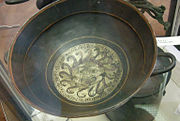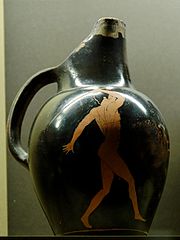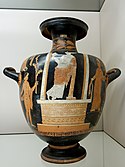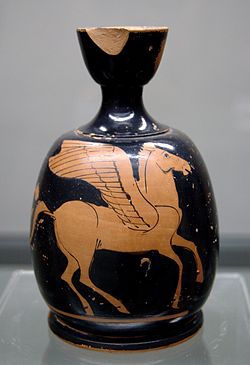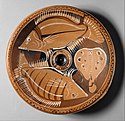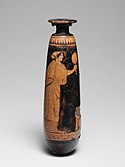Liste der griechischen Töpfer und Vasenmaler/B
Unter British Museum beziehungsweise B.M. F finden sich nur Werke der unteritalischen und sizilischen griechischen Vasenmaler. Für Kunsthandwerker des griechischen Mutterlands und Etruriens siehe unter London.
Namentlich bekannte Künstler
| |||||||||||||||||||||||||||||||||||
Nicht namentlich bekannte Künstler (Notnamen)
| |||||||||||||||||||||||||||||||||||||||||||||||||||||||||||||||||||||||||||||||||||||||||||||||||||||||||||||||||||||||||||||||||||||||||||||||||||||||||||||||||||||||||||||||||||||||||||||||||||||||||||||||||||||||||||||||||||||||||||||||||||||||||||||||||||||||||||||||||||||||||||||||||||||||||||||||||||||||||||||||||||||||||||||||||||||||||||||||||||||||||||||||||||||||||||||||||||||||||||||||||||||||||||||||||||||||||||||||||||||||||||||||||||||||||||||||||||||||||||||||||||||||||||||||||||||||||||||||||||||||||||||||||||||||||||||||||||||||||||||||||||||||||||||||||||||||||||||||||||||||||||||||||||||||||||||||||||||||||||||||||||||||||||||||||||||||||||||||||||||||||||||||||||||||||||||||||||||||||||||||||||||||||||||||||||||||||||||||||||||||||||||||||||||||||||||||||||||||||||||||||||||||||||||||||||||||||||||||||||||||||||||||||||||||||||||||||||||||||||||||||||||||||||||||||||||||||||||||||||||||||||||||||||||||||||||||||||||||||||||||||||||||||||||||||||||||||||||||||||||||
Gruppen
| |||||||||||||||||||||||||||||||||||||||||||||||||||||||||||||||||||||||||||||||||||||||||||||||||||||||||||||||||||||||||||||||||||||||||||||||||||||||||||||||||||||||||||||||||||||||||||||||||||||||||||||||||||||||||||||||||||||||||||||||||||||||||||||||||||||||||||||||||||||||||||||||||||||||||||||||||||||||||||||||||||||||||||||||||||||||||||||||||||||||||||||||||||||||||||||||||||||||||||||||||||||||||||||||||||||||||||||||||||||||||||||||||||||||||||||||||||||||||||
Klassen
|
Werkstätten
Auf dieser Seite verwendete Medien
Autor/Urheber: Attributed to the Black Fury Painter, Lizenz: CC BY 2.5
Apollo holding a kithara. Fragment from a Apulian red-figure calyx-krater.
Woman in a naiskos, surrounded by visitors. Apulian red-figured hydria, ca. 310–300 BC.
Autor/Urheber: , Lizenz: CC0
Autor/Urheber: Picture: Marcus Cyron, Lizenz: CC BY-SA 3.0
Da ich derzeit nicht dazu komme, all meinen Bildbestand angemessen aufzubereiten, andererseits aber das material nicht sinnlos auf dem PC verkommen lassen will, habe ich mich entschlossen es mitsamt eventueller Begleittexte (die dann gelöscht werden sollten) quasi als Rohmaterial hochzuladen. Jeder ist herzlich eingeladen, Beschreibungen hinzuzufügen, Titel zu verbessern, Kategorisieren etc.
Erastes (lover) and eromenos (beloved) kissing. Detail from the tondo of a red-figure Attic cup. Date: Around 480 BCE.
(c) I, Sailko, CC BY 2.5
Gorgone. Coupe laconienne à figures noires, v. 565 av. J.-C. Conservée au Cabinet des médailles de la BnF (Paris).
Autor/Urheber: , Lizenz: CC BY-SA 3.0
Museo Claudio Faina
Autor/Urheber: ArchaiOptix, Lizenz: CC BY-SA 4.0
object type / vase shape: attic red figure volute-krater
- description neck A and B: symposion of youths and bearded men reclining on klinai, flute-player, women ... - belly A and B: amazonomachy - production place: Athens - painter: Painter of Bologna 279 - period / date: classical, ca. 450-440 BC - material: pottery (clay) - museum / inventory number: Basel, Antikenmuseum und Sammlung Ludwig BS 486 - bibliography: John D. Beazley, Attic Red-Figure Vase-Painters, Oxford 1963(2), 612, 2
- Please note: The above museum permits photography of its exhibits for private, educational, scientific, non-commercial purposes. If you intend to use the photo for any commercial aime, please contact the museum and ask for permission.Hero cult (?) ; epitaph dedicated to Oedipus on the stele. Side A of a lucanian red-figure pseudo-panathenaic amphora, ca. 380–370 BC. From Apulia
Spacer image
Autor/Urheber: Picture taken by Marcus Cyron, Lizenz: CC BY-SA 3.0
Da ich derzeit nicht dazu komme, all meinen Bildbestand angemessen aufzubereiten, andererseits aber das material nicht sinnlos auf dem PC verkommen lassen will, habe ich mich entschlossen es mitsamt eventueller Begleittexte (die dann gelöscht werden sollten) quasi als Rohmaterial hochzuladen. Jeder ist herzlich eingeladen, Beschreibungen hinzuzufügen, Titel zu verbessern, Kategorisieren etc.
Autor/Urheber: , Lizenz: CC BY 3.0
Apulian pottery in the Museo provinciale Sigismondo Castromediano
Autor/Urheber: ArchaiOptix, Lizenz: CC BY-SA 4.0
object type / vase shape: attic red figure lekythos
- description: youth in mantle sitting at a tomb stele in a gesture of grief, lekythos hanging in the background - production place: Athens - painter: Painter of Berlin 2426 - period / date: classical, ca. 450-420 BC - material: pottery (clay) - findspot: Athens - museum / inventory number: Berlin, Altes Museum (Antikensammlung) F 2427 - bibliography: John D. Beazley, Attic Red-Figure Vase-Painters, Oxford 1963(2), 1205, 2
- Please note: The above museum permits photography of its exhibits for private, educational, scientific, non-commercial purposes. If you intend to use the photo for any commercial aime, please contact the museum and ask for permission.Autor/Urheber: unknown, Lizenz: CC BY-SA 3.0
Decorated amphora in the British Museum. Figures suggested to be Achilles and Cheiron. Etruscan 500BC-480BC.
Autor/Urheber: , Lizenz: CC0
Autor/Urheber: Werkstatt des Baltimore-Malers, Lizenz: CC BY 2.5
The rape of Persephone: Hades (on the right) leaves his chariot driven by a winged Erinye; Persephone (unseen here) tries to escape. Side B of a loutrophoros made of fired and painted clay in Apulia (Magna Graecia), by the red-figure technique, between 330 and 320 BC approx.
Autor/Urheber: Painter of Vatican G 31, Lizenz: CC BY-SA 3.0
Autor/Urheber: Attributed to the Painter of the Bari Orestes, Lizenz: CC BY 2.5
Woman and two Oscan youths carrying a nestoris, cakes and a basket of grapes, perhaps a Dionysiac scene. Side A from a Apulian red-figure column-krater.
Autor/Urheber: , Lizenz: CC BY-SA 4.0
Dieses Bild zeigt ein Denkmal, das zum Kulturerbe Italiens gehört. Dieses Denkmal nimmt am Wettbewerb Wiki Loves Monuments Italia 2016 teil.
Banquet scene. Side A from a Attic black-figure kantharos, ca. 560 BC.
Javelin thrower. Attic red-figured oinochoe, ca. 450 BC.
Autor/Urheber: , Lizenz: CC0
Autor/Urheber: Painter of Bologna 228, Lizenz: CC BY-SA 3.0
Autor/Urheber: Picture: Marcus Cyron, Lizenz: CC BY-SA 3.0
Da ich derzeit nicht dazu komme, all meinen Bildbestand angemessen aufzubereiten, andererseits aber das material nicht sinnlos auf dem PC verkommen lassen will, habe ich mich entschlossen es mitsamt eventueller Begleittexte (die dann gelöscht werden sollten) quasi als Rohmaterial hochzuladen. Jeder ist herzlich eingeladen, Beschreibungen hinzuzufügen, Titel zu verbessern, Kategorisieren etc.
Autor/Urheber: ArchaiOptix, Lizenz: CC BY-SA 4.0
object type / vase shape: attic red figure oinochoe shape 3 (chous)
- description: Athena "Ergane" modelling the statue of a horse in clay (the model for the Trojan horse?), on the left hang saw and drill with bow - production place: Athens - painter: Group of Berlin 2415 - period / date: early classical, ca. 470-460 BC - material: pottery (clay) - findspot: Capua - museum / inventory number: Berlin, Altes Museum (Antikensammlung) F 2415 - bibliography: John D. Beazley, Attic Red-Figure Vase-Painters, Oxford 1963(2), 776, 1
- Please note: The above museum permits photography of its exhibits for private, educational, scientific, non-commercial purposes. If you intend to use the photo for any commercial aime, please contact the museum and ask for permission.Autor/Urheber: , Lizenz: CC0
Rasende Mänade. In den rechten Hand hält sie einen Thyrsosstab, mit den Linken schleudert sie einen Panther durch die Luft. Eine züngelnde Schlange windet sich zum Diadem in ihrem Haar. Tondo einer attisch-weißgrundigen Kylix, 490-480 v. Chr. Aus Vulci.
Pegasos. Attischer rotfiguriger Bauchlekythos, 480-460 v. Chr. Aus Sizilien.
Ganymede holding a hoop, symbol of his youth, and a cock, a traditional pederastic gift. Side A from an Attic red-figure bell-krater, ca. 500–490 BC. Side B: Zeus in pursuit.
Autor/Urheber: ArchaiOptix, Lizenz: CC BY-SA 4.0
object type / vase shape: attic red figure epinetron / onos
- description side A and B: woman with alabastron sitting on stool between 2 standing draped youths with staffs - front: head of a woman - production place: Athens - painter: Painter of Berlin 2624 - period / date: classical, ca. 430-420 BC - material: pottery (clay) - findspot: Athens - museum / inventory number: Berlin, Altes Museum (Antikensammlung) F 2624 - bibliography: John D. Beazley, Attic Red-Figure Vase-Painters, Oxford 1963(2), 1225, 1
- Please note: The above museum permits photography of its exhibits for private, educational, scientific, non-commercial purposes. If you intend to use the photo for any commercial aime, please contact the museum and ask for permission.Herakles (centre-left) pursues Kyknos (centre-right) while Athena (left) and Ares (right) stand ready to join in; Zeus (centre) parts the fighters. Attic black-figured amphora, ca. 550–530 BC. From Kameiros in Rhodes.
Autor/Urheber: unknown (picture), Lizenz: CC0
Attisch-rotfigurige Bauchamphora mit der Darstellung von Artemis und Aktaion (Seite A) und Argos bewacht Io (Seite B)); dem Eucharides-Maler (John D. Beazley) und dem Töpfer der Amphora von Berlin (Hansförg Bloesch) zugeschrieben; Ton, um 480 v. Chr. (Spätarchaik/Frühklassik/Strenger Stil); heute im Museum für Kunst & Gewerbe Hamburg, Inventarnummer 1966.34; Gesamt: Höhe: 64,00 cm; Durchmesser: 40,00 cm; Mündungsdurchmesser: 29,20 cm; Durchmesser: 22,20 cm (Fuß); Breite: 5,80 cm (Henkel (5,5 und 5,8 cm)), Bildmaß: Höhe: 13,70 cm; Inschrift: Hals Seite A: rechts neben dem Körper der Artemis Αρτεμις / über Aktaion's Kopf Ακτα[ι]ον, retr. (geschrieben als Ακταον) Hals Seite B: hερμες. Αργος. καλε, Inschrift: unter dem Fuß
(c) Bryn Mawr College, CC BY-SA 3.0
Autor/Urheber: , Lizenz: CC0
Autor/Urheber: , Lizenz: CC BY 3.0
Apulian pottery in the Museo provinciale Sigismondo Castromediano
Two draped ephebes surrounding a fleeing woman. Attic red-figure ram's head rhyton, ca. 470–460 BC. From Nola?
Autor/Urheber: , Lizenz: CC BY 3.0
Apulian pottery in the Museo provinciale Sigismondo Castromediano
Autor/Urheber: , Lizenz: CC BY-SA 4.0
Dieses Bild zeigt ein Denkmal, das zum Kulturerbe Italiens gehört. Dieses Denkmal nimmt am Wettbewerb Wiki Loves Monuments Italia 2016 teil.
Autor/Urheber: Picture taken by Marcus Cyron, Lizenz: CC BY-SA 3.0
Fragment eines attisch-schwarzfigurigen Kyathos der Gruppe von Berlin F 2095 (Namenvase; Zuschreibung durch John D. Beazley) mit der Darstellung einer nackten, einen Phallusvogel reitenden Frau zwischen zwei Augen. Die ebenfalls erhaltene zweite Hälfte des Gefäßes in der Antikensammlung Berlin zeigt eine Mänade zwischen zwei Augen. Ende 6./Anfang 5. Jh. v. Chr. Antikensammlung Berlin/Altes Museum, Inventarnummer F 2095.
Autor/Urheber: Sailko, Lizenz: CC BY-SA 3.0
Museo Claudio Faina
Autor/Urheber:
Lekythos. Theseus, Minotaur and Athena in the Labyrinth. From Vari. By the Beldam Painter. About 480 BC.
Herakles bringt den erymantischen Eber zu König Eurystheus (in ein Pithos geflüchtet), Athena links und Mutter des Eurystheus rechts. A-Seite einer schwarzfigurigen attischen Amphora, um 510 v. Chr.
Woman in a naiskos. Detail from an Apulian red-figured barrel-shaped amphora, ca. 320 BC. From Bari.
Autor/Urheber: , Lizenz: CC0
Autor/Urheber: Marcus Cyron, Lizenz: CC BY-SA 3.0
Befreiung des Prometheus auf einem apulisch-rotfigurigen Kelchkrater mit aufgesetzten Farben des Branca-Malers, um 350/25 v. Chr., Antikensammlung Berlin/Pergamonmuseum, Inventarnummer 1969,9, Höhe 57 cm, erworben 1969
Herakles treibt Kerberos vor sich her. Die Bestie sieht drohende aus, wendet einen Kopf zurück und stellt ihre Schwanzschlange auf. A-Seite einer schwarzfigurigen attischen Halsamphora mit Fehlbrand, um 540 v. Chr. Aus Vulci.
Autor/Urheber: Sailko, Lizenz: CC BY-SA 4.0
Dieses Bild zeigt ein Denkmal, das zum Kulturerbe Italiens gehört. Dieses Denkmal nimmt am Wettbewerb Wiki Loves Monuments Italia 2017 teil.
Artemis Bendis, Apollo, Hermes and a young warrior. Side A of an Apulian red-figure bell-shaped krater, ca. 380–370 BC.
Autor/Urheber: Vassil, Lizenz: CC0
Plastic rhyton with donkey's head, by the Bordeaux Painter, from Athens, about 460 BC. Found at Nola. British Museum, room 20a, showcase 14. Beazley Archive
This amphora with a flaring offset mouth depicts Poseidon and Athena on one side and Hermes on the other.
Poseidon stands in profile to the right with his left foot propped up on a rock and his left arm bent and resting on his left knee. In his right hand he holds a trident upright which extends into the ornament above. A mantle is draped around his back, right thigh, and over his left leg. Athena stands to the left holding a spear upright in her right hand, and she has a shield with a Gorgoneion and a star device on her left arm. She wears a peplos girded at the waist, necklace, bracelet, and Attic helmet.
Hermes is depicted standing to the left. He holds a kerykeion in his right hand at waist level and wears a pestasos, chlamys, and mask (?). Behind him is a stele on which his left arm rests, while to the left and right are olive trees which fill the areas underneath the handles.
The subject matter is not the usual for Panathenaic amphorae, which normally have Athena on one side and athletes on the other. Poseidon and Athena are here depicted calmly standing and facing one another on the front, a juxtaposition which brings to mind their contest for the city of Athens. This story is first known to have been depicted in the west pediment of the Parthenon, but there is no sign of strife in our scene.
If Hermes wears a mask, as the black line running from his chin up suggests, the scene may in some way have been influenced by a dramatic performance. The generally poor quality of drawing, however, makes it impossible to determine if the painter meant to indicate a mask or not. The olive trees beneath the handles are approporiate fillers because of the tree's association with Athena, the story of the contest, Panathenaic ampohorae, and the Panathenaia.Herakles erwürgt den Löwen, zwischen Iolaos und Athena. Seite A einer schwartzfigurigen attischen Halsamphora, 520-510 v. Chr. Aus Vulci.
Autor/Urheber: Picture taken by Marcus Cyron, Lizenz: CC BY-SA 3.0
Da ich derzeit nicht dazu komme, all meinen Bildbestand angemessen aufzubereiten, andererseits aber das material nicht sinnlos auf dem PC verkommen lassen will, habe ich mich entschlossen es mitsamt eventueller Begleittexte (die dann gelöscht werden sollten) quasi als Rohmaterial hochzuladen. Jeder ist herzlich eingeladen, Beschreibungen hinzuzufügen, Titel zu verbessern, Kategorisieren etc.
This pelike depicts a man and woman flanking a stele on the front. The man stands in profile to the right and holds a staff in his right hand. He wears a mantle and wreath. The woman stands to the left and holds up a mirror in her right hand with her left arm bent at her side. She wears a chiton, mantle, and sakkos. Between them is a stele on a two step base with a fillet tied around it near the top.
On the back, two mantled youths are depicted walking towards one another. The mantle of the one on the left covers the back of his head.
The fillet wrapped around the stele suggests it marks a grave. If so, this would be one of the earliest red-figure vases with a scene at a grave. It is at this time that grave stelae start to appear on white-ground lekythoi and a few red-figure vases. It has been suggested that the graves in the Demosion Sema were the visual source for these depictions.Orestes and Pylades in Tauris. Detail from a Campanian red-figure krater, ca. 330 BC–320 BC. From Italy.
Exhibit in the Museo Gregoriano Etrusco - Vatican Museums.
King enthroned. Side B from a black-figure Nikosthenic amphora, ca. 530 BC.
Autor/Urheber: Picture: Marcus Cyron, Lizenz: CC BY-SA 3.0
Da ich derzeit nicht dazu komme, all meinen Bildbestand angemessen aufzubereiten, andererseits aber das material nicht sinnlos auf dem PC verkommen lassen will, habe ich mich entschlossen es mitsamt eventueller Begleittexte (die dann gelöscht werden sollten) quasi als Rohmaterial hochzuladen. Jeder ist herzlich eingeladen, Beschreibungen hinzuzufügen, Titel zu verbessern, Kategorisieren etc.
Autor/Urheber: ArchaiOptix, Lizenz: CC BY-SA 4.0
object type / vase shape: Paestan red figure bell-krater
- description side A: 5 young hunters with a white dog hunting a boar - side B: 2 draped youths in conversation - production place: Poseidonia / Paestum - painter: Painter of the Boston Orestes (style of Python) - period / date: late classical, ca. 340-320 BC - material: pottery (clay) - height: 58.4 cm - findspot: Sant´Agata de´Goti - museum / inventory number: London, British Museum 1865,0103.18 / Cat. Vases F 154 - bibliography: Arthur Dale Trendall, The red-figured vases of Paestum, Rome 1987, cat. 2/1001 - CVA London BM 2, plate 2.4a-b - https://www.britishmuseum.org/collection/object/G_1865-0103-18
- Please note: The above museum permits photography of its exhibits for private, educational, scientific, non-commercial purposes. If you intend to use the photo for any commercial aim, please contact the museum and ask for permission.Autor/Urheber: Painter of the Boston Phiale, Lizenz: CC BY-SA 3.0
Zwei laufende, bewaffnete Amazonen in orientalischer Tracht auf der Vorderseite und einem Manteljüngling auf der Rückseite einer Pelike des Malers der Bostoner Phiale, Um 440/35 v. Chr., gefunden in Unteritalien, Höhe 34 cm, Staatliche Antikensammlungen, Inventarnummer 2351
Achilleus und Ajax bei Brettspiel. B-Seite einer schwarzfigurigen attischen Halsamphora, um 530 v. Chr.
Autor/Urheber: Sailko, Lizenz: CC BY 3.0
Ancient Greek red-figure pottery in the Museo archeologico nazionale (Tarquinia)
Autor/Urheber: , Lizenz: CC0
Autor/Urheber: Picture taken by Marcus Cyron, Lizenz: CC BY-SA 3.0
Attisch-weißgrundige Lekythos des Bosanquet-Malers (Zuweisung durch John D. Beazley). Grabszene: Schmale Grabstele mit Ornamentleiste und verkümmerten, bis ins Mäanderband ragende Volutenakroteren auf dreistufigem Unterbau; links eine mit Chiton bekleidete Frau mit Alabastron in der rechten Hand und Diphros auf flachem Kissen auf dem Kopf; rechts weitere mit Peplos bekleidete Frau mit Lekythos in erhobener linken Hand. Um 450/40 v. Chr.; 1893 im Fundort Athen für die Antikensammlung Berlin erworben, Inventarnummer V.I. 3291; ARV 2 1227,9; Addenda 2 350; BA 216 337; CVA Deutschland 89/Berlin 12, Tafel 23.
Autor/Urheber: , Lizenz: CC0
Bellerophon mounted on Pegasus fighting the Chimera. Side A from an Attic red-figure pelike, ca. 440 BC.
Autor/Urheber: Picture taken by Marcus Cyron (photo), Lizenz: CC BY-SA 3.0
Früher Schwarzfiguriger Skyphos-Krater des Malers von Berlin A34, A-Seite mit Schwänen, B-Seite mit Spiralornamenten und Schwanenköpfen, um 630 v. Chr., gefunden im Vourvas-Tumulus in Attika, Archäologisches Nationalmuseum Athen(993)
Autor/Urheber: Picture taken by Marcus Cyron, Lizenz: CC BY-SA 3.0
Da ich derzeit nicht dazu komme, all meinen Bildbestand angemessen aufzubereiten, andererseits aber das material nicht sinnlos auf dem PC verkommen lassen will, habe ich mich entschlossen es mitsamt eventueller Begleittexte (die dann gelöscht werden sollten) quasi als Rohmaterial hochzuladen. Jeder ist herzlich eingeladen, Beschreibungen hinzuzufügen, Titel zu verbessern, Kategorisieren etc.
Autor/Urheber: , Lizenz: CC BY-SA 4.0
Dieses Bild zeigt ein Denkmal, das zum Kulturerbe Italiens gehört. Dieses Denkmal nimmt am Wettbewerb Wiki Loves Monuments Italia 2016 teil.
Autor/Urheber: Sailko, Lizenz: CC BY 3.0
Ancient Greek pottery in the Antikensammlung Berlin
Autor/Urheber: Picture taken by Marcus Cyron, Lizenz: CC BY-SA 3.0
Da ich derzeit nicht dazu komme, all meinen Bildbestand angemessen aufzubereiten, andererseits aber das material nicht sinnlos auf dem PC verkommen lassen will, habe ich mich entschlossen es mitsamt eventueller Begleittexte (die dann gelöscht werden sollten) quasi als Rohmaterial hochzuladen. Jeder ist herzlich eingeladen, Beschreibungen hinzuzufügen, Titel zu verbessern, Kategorisieren etc.
Autor/Urheber: Painter of Brussels R 330, Lizenz: CC BY 3.0
Female musician and dancer. Neck of a plastic rhyton in the shape of a donkey's head. From Athens.
Autor/Urheber: Image by Marcus Cyron; Art work see description, Lizenz: CC BY-SA 4.0
Etruskisch-schwarzfigurige Amphora des Malers von Berlin 2154 (Namenvase)
- A-Seite: Paris-Urteil: drei Göttinnen und der einen Widder auf den Armen tragende Gott Hermes
- B-Seite: Dionysos/Fufluns zwischen einem Jüngling und zwei Frauen, von denen eine einen Panther an einem Strick führt
- auf der Schulter ein Wagenrennen, das die Totenspiele symbolisiert
Autor/Urheber: Sailko, Lizenz: CC BY-SA 3.0
Monsters Exhibition (Palazzo Massimo, Rome, 2014)




































